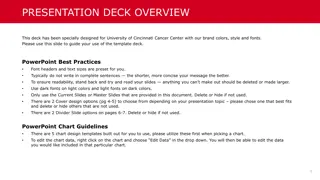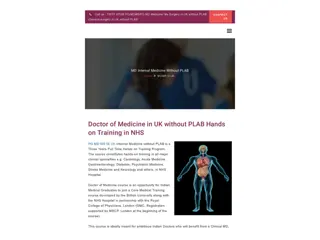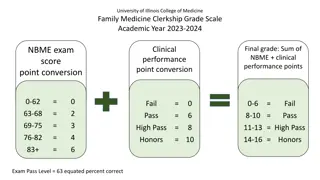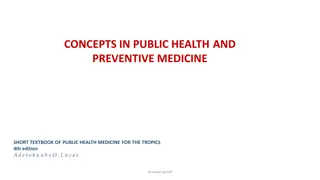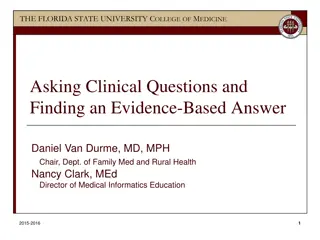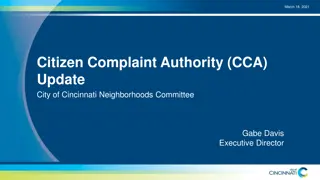Professor David I. Bernstein, MD at University of Cincinnati College of Medicine
Join Professor David I. Bernstein, MD, a distinguished faculty at the University of Cincinnati College of Medicine, with expertise in Immunology, Allergy, and Rheumatology. Explore the fascinating intersections of Medicine and Environmental Health through the lens of cutting-edge research and education in Cincinnati, Ohio.
Download Presentation

Please find below an Image/Link to download the presentation.
The content on the website is provided AS IS for your information and personal use only. It may not be sold, licensed, or shared on other websites without obtaining consent from the author.If you encounter any issues during the download, it is possible that the publisher has removed the file from their server.
You are allowed to download the files provided on this website for personal or commercial use, subject to the condition that they are used lawfully. All files are the property of their respective owners.
The content on the website is provided AS IS for your information and personal use only. It may not be sold, licensed, or shared on other websites without obtaining consent from the author.
E N D
Presentation Transcript
Faculty David I. Bernstein, MD Professor of Medicine and Environmental Health Division of Immunology, Allergy and Rheumatology University of Cincinnati College of Medicine Cincinnati, Ohio Amy S. Paller, MD Walter J. Hamlin Professor and Chair of Dermatology Professor of Pediatrics Northwestern University Feinberg School of Medicine Chicago, Illinois
Program Overview Video 1. Epidemiology Video 2. Pathophysiology Video 3. Clinical Assessment Video 4. Medical Management: Overview Video 5. Medical Management 1 Video 6. Medical Management 2 Video 7. Prevention of Flares Video 8. Emerging Therapies
Learning Objectives After participating in this program, the participant will be able to: 1) Examine the epidemiology and pathogenesis of AD and the relevance to the management of patients with AD . 2) Integrate a proactive approach to long-term disease management in AD, with a focus on prevention of flares, assessment of disease activity, and patient education. 3) Discuss the mechanisms, efficacy, and safety data for emerging biologic therapies and which patients are likely to benefit.
Video 1 EPIDEMIOLOGY
Atopic Dermatitis: Definition Chronic, pruritic, eczematous skin disease1,2 Often associated with elevated serum IgE levels and a personal or family history of type I allergies, allergic rhinitis, and asthma Atopic dermatitis = atopic eczema1 Atopic dermatitis eczema ICD codes for atopic dermatitis and eczema are different 1. Eichenfield LF, et al. J Am Acad Dermatol. 2014;70(2):338-351. 2. Whiteley J, et al. Curr Med Res Opin. 2016;doi:10.1080/03007995.2016.1195733.
Case Scenario: Emily HPI: Emily is being seen for her 6-month well- child visit Red cheeks with edema and exudation Emily has dry skin with generalized itching, sometimes making it difficult for her to fall asleep Medications: none Allergies: dairy products aggravate skin itching and rash FH: father and mother with seasonal allergic rhinitis PE: skin facial eczema, xerosis of face, as well extensor surfaces of joints
Atopic Dermatitis: Epidemiology Occurs most frequently in children, but also affects adults1,2 Up to 25% of children Up to 7% of adults Prevalence higher in women than men2,3 Onset commonly between ages of 3 and 6 months1,2 60% by age 1 year 85% to 90% by age 5 years 1. Eichenfield LF, et al. J Am Acad Dermatol. 2014;70(2):338-351. 2. Guttman-Yassky E, et al. J Allergy Clin Immunol. 2011;127(5):1110-1118. 3. Whiteley J, et al. Curr Med Res Opin. 2016;doi:10.1080/03007995.2016.1195733.
Atopic Dermatitis: Epidemiology (cont) Severity1 In children Mild (two-thirds), moderate (one-quarter); severe (<10%) Percentage of people with severe AD increases with age Pooled analysis of 45 studies (N=110,651) showed2 Children who developed AD by age 2 y had less persistent disease 80% of children with AD had disease resolution by 8 years after diagnosis, >95% by 20 years after diagnosis Later age of onset and greater severity more persistent AD 1. Chernyshov PV, et al. Clin Cosmet Investig Dermatol. 2016;9:159-166. 2. Kim JP, et al. J Am Acad Dermatol. 2016;75(4):681-687.
Atopic Dermatitis: Epidemiology (cont) Study of infants (age 3-18 mos) with recent onset AD ( 3 mos) showed many developed an allergic condition over 3 years Asthma (10.7%) Allergic rhinitis (22.4%) Food allergy (15.9%) Allergic conjunctivitis (14.1%) 1 atopic comorbidity (37.0%) Schneider L, et al. Pediatr Dermatol. 2016;33(4):388-398.
Atopic Dermatitis: Epidemiology (cont) Impact on children varies over time 0-3 years: parental exhaustion, emotional distress impaired mother-child attachment 3-10 years: teasing, bullying, avoid social interactions and sports 10 years to adulthood: low self-esteem Chernyshov PV, et al. Clin Cosmet Investig Dermatol. 2016;9:159-166.
Video 2 PATHOPHYSIOLOGY
Pathogenic Mechanisms in Acute Atopic Dermatitis Immune triggers stimulate the release of inflammatory mediators Peng W, et al. Clin Exper Allergy. 2015;45:566-574.
Pathophysiology Complex interplay of 3 factors Barrier dysfunction Immunological Environmental Barrier Dysfunction Environmental Factors Ceramide reduction Climate Smoking Increased proteases Skin pH Filaggrin deficiency Microbiome Pruritus Th2 cells Th17 cells Tregs ILC2 Eosinophils Mast cells Immunological Factors Egawa G, et al. Cogent Biol. 2015;1;1103459.
Disease Biomarkers Are Needed Biomarkers are being identified to1,2: Facilitate diagnosis Assess disease severity Identify AD disease phenotypes targeted therapy Predict individual responses to medications 1. Mansouri Y, et al. J Clin Med. 2015;4:858-87. 2. Thijs JL, et al. J Clin Med. 2015:4:479-487.
Video 3 CLINICAL ASSESSMENT
Case Scenario: Jack Jack is a 13-year-old male, accompanied by his mother. During the visit, he is noted to frequently scratch the flexural areas of his arms. History: Jack has complained of dry, itchy skin on his arms for many years that worsened over the past 2 years. Symptoms are worse in the winter. Mother had asthma and father has seasonal allergies Jack has asthma since 4 years of age PE: Dry skin Erythema, dryness, lichenification noted in flexural areas of both arms - Hyperlinear palms and increased scaling on legs - Mom also shows hyperlinear palms/dry legs Image courtesy of DermNetNZ.org under the Creative Commons Attribution-NonCommercial-NoDerivs 3.0 (http://creativecommons.org/licenses/by-nc-nd/3.0/nz/) with no changes.
Patient Assessment in Routine Clinical Practice Recommended as part of PE General questions Itch Impact on daily activity, sleep Disease persistence Associated conditions Rhinitis/Rhinoconjunctivitis Asthma Food allergy Sleep disturbance Depression Not recommended in practice Disease severity measurement scales* Quality of life measurement scales *Not recommended outside of a clinical trial. US Food and Drug Administration requires Investigator Global Assessment that is used for product labeling. Eichenfield LF, et al. J Am Acad Dermatol. 2014;70:338-351.
Risk Factors Strong association Family history of atopy Odds of developing atopic dermatitis Moderate association African-American race Higher parental education Unclear association Pet exposure Urban living Daycare Both parents are atopic: 3 to 5-fold higher risk Loss of function mutations in the FLG gene (minority 10% or less) Earlier onset More severe, persistent disease Eczema herpeticum Eichenfield LF, et al. J Am Acad Dermatol. 2014;70:338-351. Kelleher et al. JACI 2015;135:930-935.
Transepidermal Water Loss at 2 Days of Life as a Predictor of Atopic Dermatitis Odds Ratio (OR) of Developing Atopic Dermatitis* 8 Odds Ratio of Developing Atopic Interpretation: Infants in top quartile at 2 days are 7.1 times more likely to be diagnosed with AD at 1 year. 7 6 Dermatitis 5 4 3 2 1 0 N=1903 infants 2 Days Kelleher M, et al. J Allergy Clin Immunol. 2015;135(4):930-935. *Patients were grouped by percentiles based on history of parental atopy and transepidermal water loss test reading score at 2 days. TEWL threshold scores were 5.0 gwater/m2/h (25th percentile), 7.0 gwater/m2/h (50th percentile), and 9.0 gwater/m2/h (75th percentile). 1597 infants screened. At 6 months, 18.7% were diagnosed with AD. At 12 months, 15.5% were diagnosed with AD
Diagnostic Features Essential Features Pruritus Eczematous dermatitis (acute, subacute, chronic) Typical morphology and age-specific patterns Facial, neck, and extensor involvement in infants and children Current or previous flexural lesions at any age Sparing of the groin and axillary regions Chronic or relapsing history Eichenfield LF, et al. J Am Acad Dermatol. 2014;70:338-351.
Diagnostic Features (cont) Important Features (seen in most) Early age of onset Atopy Personal and/or family history IgE reactivity Xerosis Eichenfield LF, et al. J Am Acad Dermatol. 2014;70:338-351.
Distribution Age Typical Distribution 0-2 years Erythematous papules and vesicles on cheeks, forehead, scalp 3-5 years More extensor involvement and transition towards chronic disease Older children, adults Flexural folds, face/neck, upper arms/back, hands, feet, fingers, toes
Atopic Dermatitis: Differential Diagnosis Other eczematous disorders Contact dermatitis Seborrheic dermatitis Dyshidrotic eczema Hand eczema Nummular dermatitis Psoriasis Scabies Unusual disorders Ichthyoses Immune deficiency diseases Photosensitivity dermatoses Erythroderma of other causes Cutaneous T-cell lymphoma Eichenfield LF, et al. J Am Acad Dermatol. 2014;70:338-351.
Role of the Laboratory Laboratory testing not needed for most patients1 IgE level not elevated in 5% to 37%2,3 Numerous biomarkers, but none are reliable to distinguish atopic dermatitis from other inflammatory diseases4,5 Allergen skin testing helpful in those with Respiratory allergies (allergic rhinitis or asthma) Food allergies: screening will only suggest food sensitization 1. Eichenfield LF, et al. J Am Acad Dermatol. 2014;70:338-351. 2. Ott H, et al. Acta Derm Venereol. 2009;89(3):257-261. 3. Folster-Holst, et al. Allergy. 2006;61(5):629-632. 4. Thijs J, et al. Curr Opin Allergy Clin Immunol. 2015;15(5):453-460. 5. Mansouri Y, et al. J Clin Med. 2015;4:858-87.
Video 4 MEDICAL MANAGEMENT: OVERVIEW
Case Scenario: Wynonna Wynonna is a 7-year-old female diagnosed at age 9 months with AD primarily involving her forearms and lower legs Current meds: emollients 1-2 x/day + low-potency TCS Upon questioning, Wynonna reports that her pruritus has not improved, and is sometimes unbearable when she plays soccer. She also says it is sometimes difficult to fall asleep PE: moderate erythema with numerous excoriations noted on trunk, arms and legs but no sign of infection
Goals of Therapy 1. Reduce the number and severity of flares 2. Reduce pruritus and improve quality of life 3. Maintain normal activities of daily living 4. Maximize disease-free periods 5. Prevent infectious complications 6. Avoid/Minimize side effects of therapy Schneider L, et al. J Allergy Clin Immunol. 2013;131(2):295-299. Lyons JJ, et al. Immunol Allergy Clin North Am. 2015;35(1):161-183.
Overview of Atopic Dermatitis Management Mild Disease Basic Management Skin Care -Moisturizers -Warm bath/shower Trigger Avoidance Acute Treatment Low-potency TCS 2x/d applied to inflamed skin Modified from Eichenfield LF, et al. Pediatrics. 2015;136(3):554-565. TCI, topical calcineurin inhibitor; TCS, topical corticosteroid
Overview of Atopic Dermatitis Management (cont) Mild Disease Moderate-to-Severe Disease Acute Treatment Medium-potency TCS applied to inflamed skin Consider 2 infection; treat with antibiotic if present -Introduce dilute bleach baths 2-7x/wk as maintenance Basic Management Skin Care -Moisturizers -Warm bath/shower Trigger Avoidance Flare not resolved within 7 days Consider Nonadherence Misdiagnosis Referral Maintenance TCI Maintenance TCS Acute Treatment Low-potency TCS 2x/d applied to inflamed skin For relapsing course (frequent/persistent flares despite treatment) TCS applied at first signs/symptoms or to flare-prone areas Modified from Eichenfield LF, et al. Pediatrics. 2015;136(3):554-565. TCI, topical calcineurin inhibitor; TCS, topical corticosteroid
Video 5 MEDICAL MANAGEMENT I
Skin Hydration Bathing followed by immediate application of emollient Emollient Use generously - no danger from excess use Lotions vs creams vs oils vs ointments Schneider L, et al. J Allergy Clin Immunol. 2013;131(2):295-299. Eichenfield LF, et al. J Am Acad Dermatol. 2014;71(1):116-132.
Skin Hydration (cont) Bathing followed by immediate application of emollient Emollient Use generously - no danger from excess use Lotions vs creams vs oils vs ointments General recommendations are: Warm (not hot) water Bath better than shower 5-10 minutes Neutral/low pH, hypoallergenic, fragrance-free non-soap cleansers preferred Schneider L, et al. J Allergy Clin Immunol. 2013;131(2):295-299. Eichenfield LF, et al. J Am Acad Dermatol. 2014;71(1):116-132.
Skin Hydration (cont) Bathing followed by immediate application of emollient Emollient Use generously - no danger from excess use Lotions vs creams vs oils vs ointments General recommendations are: Warm (not hot) water Bath better than shower 5-10 minutes Neutral/low pH, hypoallergenic, fragrance-free non-soap cleansers preferred Bleach baths now standard of maintenance care for pediatric moderate-to-severe AD Schneider L, et al. J Allergy Clin Immunol. 2013;131(2):295-299. Eichenfield LF, et al. J Am Acad Dermatol. 2014;71(1):116-132.
Topical Corticosteroids (TCS) Recommended if symptoms are not controlled by moisturizers alone Low-potency Maintenance therapy to prevent exacerbations Intermediate- and high-potency (halogenated) Exacerbations for short period or proactive therapy Schneider L, et al. J Allergy Clin Immunol. 2013;131(2):295-299. Eichenfield LF, et al. J Am Acad Dermatol. 2014;71(1):116-132.
Topical Corticosteroids (TCS) (cont) Recommended if symptoms are not controlled by moisturizers alone Low-potency Maintenance therapy to prevent exacerbations Intermediate- and high-potency (halogenated) Exacerbations for short period or proactive therapy Ultra-high-potency No more than 1-2 weeks Non-facial, non-skinfold areas Potent, fluorinated corticosteroids should not be used on mucous membranes, face, eyelids, genitalia, and intertriginous areas or in young infants beyond a few days Schneider L, et al. J Allergy Clin Immunol. 2013;131(2):295-299. Eichenfield LF, et al. J Am Acad Dermatol. 2014;71(1):116-132.
Topical Corticosteroids (TCS) (cont) Twice-daily application needed for most until signs and symptoms improve For frequent, repeated outbreaks at the same site, maintenance proactive therapy with intermediate-potency TCS 2-3x/wk may be beneficial Schneider L, et al. J Allergy Clin Immunol. 2013;131(2):295-299. Eichenfield LF, et al. J Am Acad Dermatol. 2014;71(1):116-132.
Topical Corticosteroids (TCS) (cont) Twice-daily application needed for most until signs and symptoms improve For frequent, repeated outbreaks at the same site, maintenance proactive therapy with intermediate-potency TCS 2-3x/wk may be beneficial Adverse effects of TCS Local- striae, skin atrophy, periorbital dermatitis, rosacea, allergic contact dermatitis Systemic Dependent on skin surface area involved, skin thickness, use of occlusive dressing, duration of use, potency Risk of adrenal suppression greatest in infants and small children Schneider L, et al. J Allergy Clin Immunol. 2013;131(2):295-299. Eichenfield LF, et al. J Am Acad Dermatol. 2014;71(1):116-132.
Topical Calcineurin Inhibitors (TCI) Pimecrolimus cream 1%; tacrolimus 0.03% and 0.1% ointment Block production of proinflammatory cytokines and other inflammatory mediators1,2 Advantages vs. TCS2 For face, anogenital, skin folds, or other sensitive areas No atrophogenic properties; can reverse steroid-induced atrophy Steroid-sparing: reduce overall TCS when used for maintenance 1. Schneider L, et al. J Allergy Clin Immunol. 2013;131(2):295-299. 2. Eichenfield LF, et al. J Am Acad Dermatol. 2014;71(1):116-132.
Topical Calcineurin Inhibitors (TCI) (cont) 2-3x/wk proactive application effective in preventing recurrence1,2 Local adverse effects such as stinging and burning are most common1,2 and primarily occur when applied to acutely inflamed lesions Increased risk of malignancy not observed3, but black box warning for theoretical risk persists and requires reassurance when prescribed 1. Schneider L, et al. J Allergy Clin Immunol. 2013;131(2):295-299. 2. Eichenfield LF, et al. J Am Acad Dermatol. 2014;71(1):116-132. 3. Siegfried EC, et al. BMC Pediatr. 2016;16:75.
Other Topical Options Crisaborole: Topical phosphodiesterase-4 (PDE4) inhibitor approved in December 2016 for mild-to-moderate AD in children age 2 y
Other Topical Options (cont) Crisaborole: Topical phosphodiesterase-4 (PDE4) inhibitor approved in December 2016 for mild-to-moderate AD in children age 2 y Tar preparations1,2 No randomized trials have demonstrated efficacy Should not be used on acutely inflamed skin Tar shampoo may be beneficial 1. Schneider L, et al. J Allergy Clin Immunol. 2013;131(2):295-299. 2. Eichenfield LF, et al. J Am Acad Dermatol. 2014;71(1):116-132.
Other Topical Options (cont) Crisaborole: Topical phosphodiesterase-4 (PDE4) inhibitor approved in December 2016 for mild-to-moderate AD in children age 2 y Tar preparations1,2 No randomized trials have demonstrated efficacy Should not be used on acutely inflamed skin Tar shampoo may be beneficial Topical antihistamines1,2 Not recommended because of lack of evidence supporting efficacy, risk of absorption and of contact dermatitis Even oral anthistamines are only used in AD for their soporific effects or for associated allergic disorders (nonsedating antihistamines) 1. Schneider L, et al. J Allergy Clin Immunol. 2013;131(2):295-299. 2. Eichenfield LF, et al. J Am Acad Dermatol. 2014;71(1):116-132.
Other Topical Options (cont) Crisaborole: Topical phosphodiesterase-4 (PDE4) inhibitor approved in December 2016 for mild-to-moderate AD in children age 2 y Tar preparations1,2 No randomized trials have demonstrated efficacy Should not be used on acutely inflamed skin Tar shampoo may be beneficial Topical antihistamines1,2 Not recommended because of lack of evidence supporting efficacy, risk of absorption and of contact dermatitis Even oral anthistamines are only used in AD for their soporific effects or for associated allergic disorders (nonsedating antihistamines) Topical antimicrobials2 Not recommended because of lack of efficacy, risk of contact dermatitis Exception: antiseptic dilute bleach baths3-5 1. Schneider L, et al. J Allergy Clin Immunol. 2013;131(2):295-299. 2. Eichenfield LF, et al. J Am Acad Dermatol. 2014;71(1):116-132. 3. Hon KL, et al. J Dermatolog Treat. 2016;27(2):156-162. 4. Wong SM, et al. J Dermatol. 2013;40(11):874-880. 5. Huang JT, et al. Pediatrics. 2009;123:e808-e814.
Additional Considerations Identify and eliminate triggering factors Avoidance of common irritants soaps/detergents/wool/occlusive fabrics Potential contact allergens, such as fragrance, preservatives, botanicals Recommend control of temperature and humidity Consider possible allergy triggers (other than foods) with skin tests, although skin tests (and allergy patch tests) are poorly predictive of triggering factors Allergen immunotherapy Selected patients with aeroallergen sensitivity may worsen AD Schneider L, et al. J Allergy Clin Immunol. 2013;131(2):295-299.
Additional Considerations (cont) Identify and eliminate triggering factors Avoidance of common irritants soaps/detergents/wool/occlusive fabrics Potential contact allergens, such as fragrance, preservatives, botanicals Recommend control of temperature and humidity Consider possible allergy triggers (other than foods) with skin tests, although skin tests (and allergy patch tests) are poorly predictive of triggering factors Allergen immunotherapy Selected patients with aeroallergen sensitivity may worsen AD Limited data regarding the benefits of leukotriene inhibitors (shown to be ineffective for AD) Schneider L, et al. J Allergy Clin Immunol. 2013;131(2):295-299.
Additional Considerations (cont) Patient and family education Chronic nature of disease, exacerbating factors, efficacy and safety of treatments Demonstrate skin care techniques Provide written treatment plan Refer to other healthcare providers as needed Advise of patient support organizations Schneider L, et al. J Allergy Clin Immunol. 2013;131(2):295-299.
Additional Considerations (cont) Patient and family education Chronic nature of disease, exacerbating factors, efficacy and safety of treatments Demonstrate skin care techniques Provide written treatment plan Refer to other healthcare providers as needed Advise of patient support organizations Patient and family quality of life often impaired Additional treatment may be needed for itching, behavioral disorders, and sleep disturbances Schneider L, et al. J Allergy Clin Immunol. 2013;131(2):295-299.
Video 6 MEDICAL MANAGEMENT II
Difficult-to-Treat Patients with Atopic Dermatitis Phototherapy Narrowband UVB most commonly used due to low risk profile, relative efficacy, availability, clinician experience Incidence of adverse events considered to be low Most common are actinic damage, local erythema/tenderness, pruritus, burning, stinging Rarely used because of poor accessibility and often poorly tolerated, especially for acute AD Home phototherapy a consideration for patients with poor adherence Sidbury R, et al. J Am Acad Dermatol. 2014;71(2):327-349. Schneider L, et al. J Allergy Clin Immunol. 2013;131(2):295-299.


